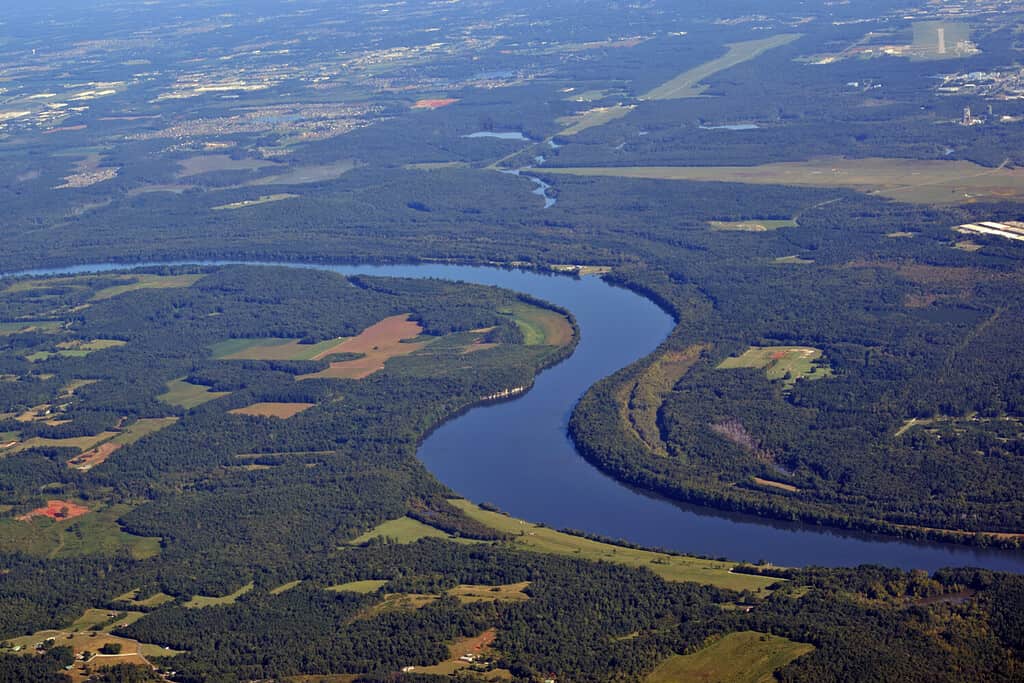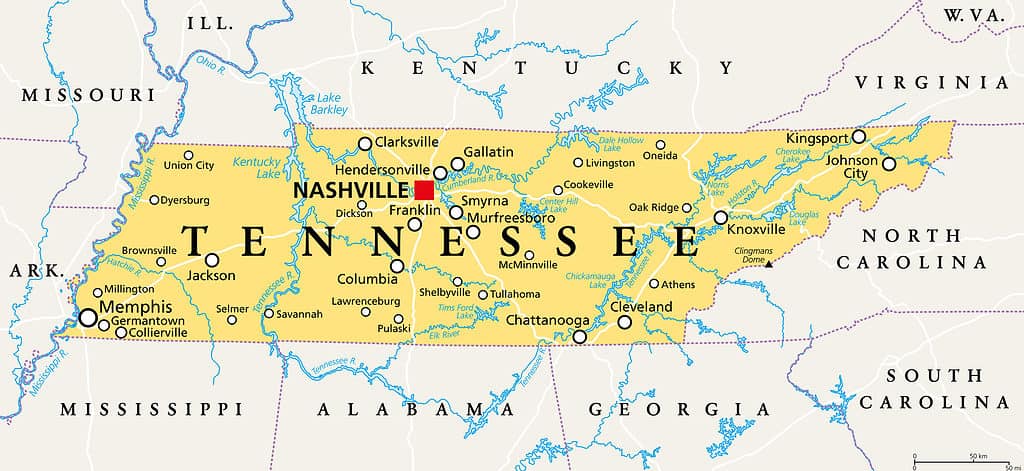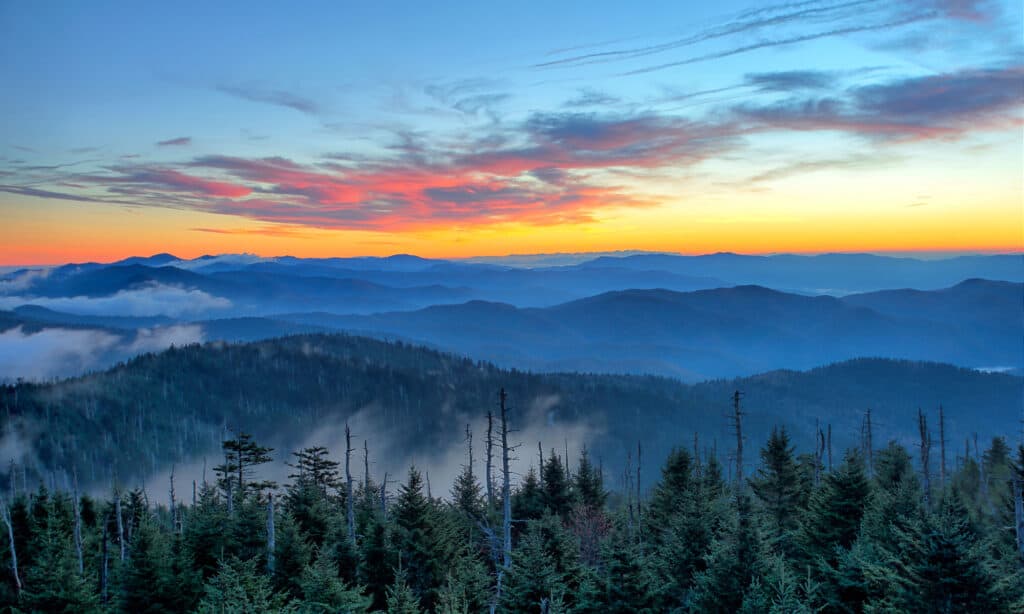Tennessee is a beautiful state to drive through, especially during fall. You can view the changing leaves, explore the mountains, and visit popular towns like Nashville or Chattanooga. But whether you’re driving through Tennessee for a state road trip or just to get through to the other side, you may be wondering how tall it is.
Tennessee is 120 miles at its tallest points north and south. Kentucky and Virginia border it in the north and Georgia, Mississippi, and Alabama in the south. It’s certainly not the shortest state in the U.S. — Rhode Island’s got that record at just 48 miles from north to south. But Tennessee is one of the smaller states from north to south. Look at its distance from east to west, and you’ll surely be more impressed.
Early Tennessee
Tennessee was the 16th state to be admitted to the Union in 1796. The area has a long history dating back to thousands of years prior to European discovery.
The area where Tennessee is today was first inhabited by Paleo-Indians 12,000 years ago during the Ice Age. From what scientists have been able to gather from fossils, the area was heavily populated by hunter-gatherers. The area holds clues as to why — fossils show that the valley was full of game animals.
When Spanish conquistadors reached the land in the 16th century, they met local tribes including the Muscogee, Creek, Yuchi, and Shawnee. Their arrival marked the beginning of the end for the native tribes, who were all but wiped out by the 18th century. The few tribe members who escaped the diseases and plagues brought by the Spaniards fled to the mountains of the state and began creating new settlements.

It’s no wonder that the area of Tennessee was so highly populated by hunter-gatherers. Nearly the whole state is full of fertile farmland and river valleys.
©Tracy Burroughs Brown/Shutterstock.com
Becoming Part of the United States
Around a hundred years after the Spanish conquistadors explored Tennessee, the English and French began sending expeditions into the land. They established forts and trade locations. As European settlers moved into the land, hostilities arose between them and the native people. The first European settlers to the land formed the Watauga Association — a semi-autonomous form of government.
At the time, much of the territory of Tennessee belonged to North Carolina, but three counties left to form the State of Franklin. When they were rejected from joining the Union, they rejoined North Carolina. Then, North Carolina ceded their territory back to the government. The government then made the three counties into an official area called the Southwest Territory. They established that the Southwest Territory would be able to reapply to join the Union once they had a population of 60,000 or more.
In 1795, the Southwest Territory legislature conducted a census and a poll of the population. It found that the area had 77,263 residents, with 6,504 in favor of becoming a state and 2,562 against. With those numbers, delegates felt they could move forward. By the next year, the state name ‘Tennessee’ was chosen, a constitution was written, and the state’s first governor — John Sevier — was selected. Tennessee became the 16th state on June 1, 1796.

Much of Tennessee was once included as part of North Carolina’s territory.
©iStock.com/PeterHermesFurian
Geography of Tennessee
Tennessee is divided into three Grand Divisions: East, Middle, and West Tennessee. They’re represented on the state flag by the three stars. East Tennessee and Middle Tennessee are separated by the Cumberland Plateau. The largest city in East Tennessee is Knoxville, and the terrain of the area is almost fully made up of the Appalachian mountains.
Middle Tennessee is less mountainous and contains more hilly terrain. The largest city in Middle Tennessee is Nashville, and Middle Tennessee is the largest of the three Grand Divisions. It’s the most fertile part of the state for farming because of the streams and valleys.
West Tennessee is mainly made of agricultural farms and land areas. The largest city in West Tennessee is Memphis and the land around the area is almost entirely flat.
Tennessee has quite a few rivers that flow through it, and many of them connect with each other. The three largest rivers in the state are the Mississippi, the Tennessee, and the Cumberland rivers. One thing that draws tourists to Tennessee is whitewater rafting, which you can do on many of the rivers. The state also brings visitors who want to try fly fishing and snorkeling in the clear rivers.

Tennessee’s Grand Divisions are represented by three stars on the state flag.
©rarrarorro/Shutterstock.com
Overall Size of Tennessee
Tennessee is a pretty average state in terms of size. It’s the 36th-largest by total area at 42,143 square miles. Most of Tennessee is made up of land area which covers 41,217 square miles, with just 926 miles of water terrain. The highest elevation in the state is Clingmans Dome at 6,643 feet, and the lowest is the Mississippi River at the border of Mississippi.
It’s 120 miles from north to south and 440 miles wide. Tennessee is pretty close in shape to Kentucky, which is 187 miles north to south and 397 miles wide.
Though Tennessee isn’t a very large state, it’s big in terms of population. Tennessee has the 15th-largest population of the U.S. states. That’s probably because it has so many large cities including Nashville, Knoxville, Memphis, and Chattanooga. There are approximately 6.9 million residents in the state.

The highest point in Tennessee surely boasts some beautiful views.
©Great Smoky Mountains National Park from Gatlinburg, TN, Public domain, via Wikimedia Commons – Original / License
Wildlife In The State
Tennessee is a rich state in terms of wildlife and nature. The Great Smoky Mountains National Park lies on the eastern border of Tennessee with half the park in North Carolina. The park spans 244,000 acres of Tennessee and is around 95 percent forested. The mountains are a part of the Blue Ridge Mountains and the Appalachian Mountain chain and are some of the highest in North America. You can find a lot of wildlife in the park, along with miles of forests and waterfalls.
Since the Great Smoky Mountains National Park is America’s most visited national park, it has a lot to offer visitors. The main visitors center in Tennessee is near Gatlinburg and it’s called the Sugarlands Visitors’ Center. The visitors center shares information about the park and its history.
The main activities that visitors partake in are hiking and sightseeing. Many people enjoy looking at the changing leaves during fall or looking for bears in the trees. Aside from these two activities, visitors also enjoy fly fishing. You can expect to see brook, brown, and rainbow trout in most of the rivers.
Another popular spot for viewing nature in Tennessee is the Big South Fork National River and Recreation Area. It’s named for the fork in the Cumberland River and the park features a large number of natural bridges.

Take one look at these views and you’ll know why the Great Smoky Mountains National Park is the most visited park in the nation!
©Trent Carmichael/Shutterstock.com
Final Thoughts
When in the national park areas or any parts of wild Tennessee, you’ll likely run into some of the native animals. Tennessee’s state animal is the raccoon, which you’re sure to see roaming about the state. You can also spot whitetail deer, black bears, cougars, and bobcats in Tennessee. Most of the animals in Tennessee are not dangerous, so treat them with respect and leave nothing but footprints when out on the trails.
Now that you know how tall Tennessee is, you can plan out your next road trip through the state. Consider visiting some of the most beautiful mountains in Tennessee or cruising around the state’s largest lakes. Whatever you end up doing, you can be sure that The Volunteer State has plenty of fun for everyone!
The photo featured at the top of this post is © iStock.com/PeterHermesFurian
Thank you for reading! Have some feedback for us? Contact the AZ Animals editorial team.







